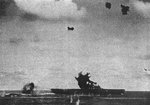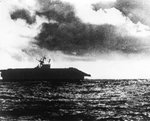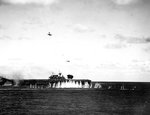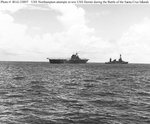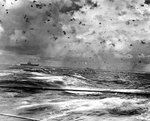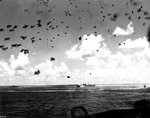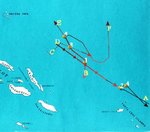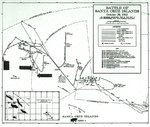syscom3
Pacific Historian
The increasing desperation of both sides of the battle for this stinking island was evident. Both the allies and the Japanese escalated the fight. While the USMC held the ground around the vital airfield, another carrier vs carrier slug fest occurred to the east. This was undoubtedly a Japanese tactical victory, but the loss of so many irreplaceable aircrews crippled Japanese carrier power for quite some time. Not untill The Battle for the Mariana Island in June 1944 were opposing carriers were to go to battle again.
Prelude
From October 20 to October 25, Japanese land forces on Guadalcanal attempted to capture Henderson Field with a large-scale attack against U.S. troops defending the airfield. However, the attack was decisively defeated with heavy casualties for the Japanese during the Battle for Henderson Field.
Incorrectly believing that the Japanese army troops had succeeded in capturing Henderson Field, a force of Japanese warships approached Guadalcanal on the morning of October 25 to provide further support for the army offensive. Aircraft from Henderson Field attacked the convoy throughout the day, sinking the light cruiser Yura and damaging the destroyer Akizuki.
Despite the failure of the Japanese ground offensive and the loss of Yura, the rest of the Combined Fleet continued to maneuver near the southern Solomon Islands on October 25 with the hope of encountering Allied naval forces in battle. The Japanese naval forces included four carriers, because Hiyō had suffered an accidental, damaging fire on October 22 that forced her to return to Truk for repairs. The Japanese naval forces were divided into three groups: The "Advanced" force contained Junyō, plus two battleships, four heavy cruisers, one light cruiser, and 10 destroyers, and was commanded by Vice Admiral Nobutake Kondo in heavy cruiser Atago; the "Main Body" consisted of Shōkaku, Zuikaku, and Zuihō plus one heavy cruiser and eight destroyers, and was commanded by Vice Admiral Chuichi Nagumo in Shōkaku; the "Vanguard" force contained two battleships, three heavy cruisers, one light cruiser, and seven destroyers, and was commanded by Rear Admiral Hiroaki Abe in battleship Hiei. In addition to commanding the Advanced force, Kondo acted as the overall commander of the three forces.
On the U.S. side, the Hornet and Enterprise task groups, under the overall command of Rear Admiral Thomas Kinkaid swept around to the north of the Santa Cruz Islands on October 25 searching for the Japanese naval forces. The U.S. warships were deployed as two separate carrier groups, each centered on either Hornet or Enterprise, and separated from each other by about 10 nm. A U.S. PBY Catalina based in the Santa Cruz Islands located the Japanese Main body carriers at 11:03. However, the Japanese carriers were about 355 nm from the U.S. force, just beyond carrier aircraft range. Kinkaid, hoping to close the range to be able to execute an attack that day, steamed towards the Japanese carriers at top speed and, at 14:25, launched a strike force of 23 aircraft. But the Japanese, knowing that they had been spotted by U.S. aircraft and not knowing where the U.S. carriers were, turned to the north to stay out of range of the U.S. carriers' aircraft. Thus, the U.S. strike force returned to their carriers without finding or attacking the Japanese warships.
Carrier action on October 26 - first strikes
At 02:50 on October 26, the Japanese naval forces reversed direction and the naval forces of the two adversaries closed the distance until they were only 200 nm away from each other by 05:00. Both sides launched search aircraft and prepared their remaining aircraft to attack as soon as the other side's ships were located. Although a radar-equipped PBY Catalina sighted the Japanese carriers at 03:10, the report did not reach Kinkaid until 05:12. Therefore, believing that the Japanese ships had probably changed position during the last two hours, he decided to withhold launching a strike force until he received more current information on the location of the Japanese ships.
At 06:45, a U.S. scout aircraft sighted the carriers of Nagumo's Main body. At 06:58, a Japanese scout aircraft reported the location of Hornet's task force. Both sides raced to be the first to attack the other. The Japanese were first to get their strike force launched, with 64 aircraft, including 21 "Val" dive bombers, 20 "Kate" torpedo bombers, 21 Zero fighters, and two "Kate" command and control aircraft on the way towards Hornet by 07:40. Also at 07:40, two U.S. SBD Dauntless scout aircraft, responding to the earlier sighting of the Japanese carriers, arrived and dove on Zuihō. With the Japanese combat air patrol (CAP) busy chasing other U.S. scout aircraft away, the two U.S. aircraft were able to approach and drop both of their bombs on Zuihō, causing heavy damage and preventing the carrier's flight deck from being able to land aircraft.
Meanwhile, Kondo ordered Abe's Vanguard force to race ahead to try to intercept and engage the U.S. warships. Kondo also brought his own Advanced force forward at maximum speed so that Junyō's aircraft could join in the attacks on the U.S. ships. At 08:10, Shōkaku launched a second wave of strike aircraft, consisting of 19 Vals and eight Zeros, and Zuikaku launched 16 Kates at 08:40. Thus, by 09:10 the Japanese had 110 aircraft on the way to attack the U.S. carriers.
The U.S. strike aircraft were running about 20 minutes behind the Japanese. Believing that a speedy attack was more important than a massed attack, the U.S. aircraft proceeded in small groups towards the Japanese ships instead of forming into one large strike force. The first group, consisting of 15 SBD dive bombers, six TBF Avenger torpedo bombers, and eight F4F Wildcat fighters from Hornet, was on its way by about 08:00. A second group, consisting of three SBDs, seven TBFs, and eight Wildcats from Enterprise was off by 08:10. A third group, which included nine SBDs, eight TBFs, and seven Wildcats from Hornet, was on its way by 08:20.
At 08:30, the opposing aircraft strike formations began passing within sight of each other. Nine Zeros from Zuihō broke off from their formation and attacked the Enterprise group of aircraft. In the resulting engagement, four Zeros, three Wildcats, and two TBFs were shot down, with another two TBFs forced to return to Enterprise with heavy damage.


